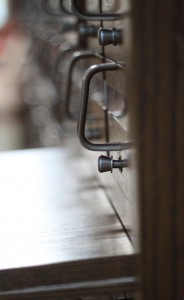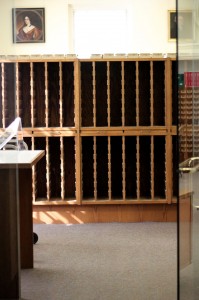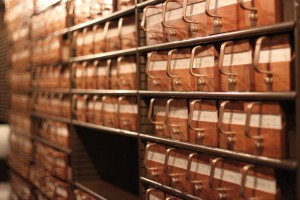
This is the type of post which started out as an “In Memoriam.” Something lighthearted which included lines about the deceased card catalog’s birth in the 1970s, it being a ‘descendent of generations of particleboard furniture’ and that it ‘leaves behind grieving relations such as the filing cabinet, map drawer, etc.’ But the more I thought about the current standing of the card catalog, the clearer it became that it was not “In Memory” but “In Honor.” The card catalog is not dead – it is archived. A large portion of it is still among the living. So the tone started to change. But then things took another turn.
The American Antiquarian Society’s Facebook page posted a pretty provocative photograph this weekend. I felt the same way many viewers did when they first saw it. My jaw dropped. My heart hurt. And while it doesn’t tell the whole story, the response was strong. And anxious. Perhaps because it depicts the Antiquarian Society in the active process of disposing – incompatible bedfellows to say the least.

I’ll be the first to state that card catalogs, at first, seem a crashing bore. Until you post a picture of it in a pile. In it, parts of the former card catalog from the AAS reading room were seen out of their context in the Great Outdoors. At first glance, it’s intense – but if you look closely you will see what’s missing: most of the card drawers and all of the cards.
Perhaps a bit of backstory. This September was the targeted date for the removal of most of the card catalogs from the AAS Reading Room. After all, cards have not been filed in the general catalog since 1995; but we had to keep most of its contents, as some cards date to the 1880s. The decision was one which has been on-the-table/off-the-table for over a decade – with bicentennial activities coming up for this October, the time seemed right to make A Move.
The catalogs still actively used (maps, sheet music, printers’ file and checklist drawers) are still in the reading room. The lion’s share was retained and moved on carts by staffers to the ground level – accessible yes, but in the stacks which are closed to readers. Contained here are the Imprints and first editions, the old general catalog and the newspaper catalog, and representative samples from the other catalogs. The remaining catalogs (and their furniture) were offered up as souvenirs and then recycled. In an email to the staff, the Marcus A.

McCorison Librarian and Curator of Manuscripts Tom Knoles noted that the catalog has been:
a daily presence for as long as we’ve worked here… the card catalogs tell the history of AAS collections and cataloging over a period of more than a century. It will be a venerable and worthy part of the AAS archives.
In a fascinating article published last September, “Serving Higher Education’s Highest Goals: Assessment of the Academic Library as Place” authors Heather Lea Jackson and Trudi Bellardo Hahn consider the library space as one which has components (stacks, card catalogs, furniture, arrangement, etc.) which stimulate a desire for researchers to feel connected to a higher, abstract if you will, mission.[1] Beginning with Mircea Eliade’s classic The Sacred and the Profane, the authors consider how we experience “space, time, nature and life in religious and nonreligious ways.” (428). They further highlight that the library-as-space has been held in frequent conversation seeing that “the field faces a potential crisis related to technological progress and mass digitization” (430). This is, by no means, new. Former AAS Fellow Thomas Augst noted this connection in his essay “Faith in Reading: Public Libraries, Liberalism, and the Civil Religion”[2] but the resurfacing of this argument and the disposal of items continuously held in reverence is one underscored by our response to its absence and removal. The card catalog was a necessary component of nonreligious space which kindled an emotional response.
Part of what seems to have happened (and continues to happen) is a mourning for the card catalog – items which served as the nucleus for access to the materials. They have moved from a public space to an archival space. And that sudden change is visible. Most ‘archive’ items are enveloped in a weaning period – where items ended up sitting on dusty shelves, attics, basements, etc. prior to becoming fodder for the archive. In short, the card catalog was another way of serendipitously shelf-browsing in a place with closed stacks. And now that opportunity and form of access is gone. And so we remember it for what it was – in a place and in a time. Arrested. Which is not unlike all other items already archived which have become preserved, reformatted, recollected, assembled and integrated. So we’ve come full circle. Perhaps this piece is, as originally intended, an “In Memorium” for a staple of the Reading Room space which has made the Great Move On.
[1] College & Research Libraries. September 2011, Vol. 72 Issue 5, pages 428-442.
[2] In Institutions of Reading: The Social Life of Libraries in the United States, eds. Thomas Augst and Kenneth Carpenter (Amherst: University of Massachusetts Press, 2007).
